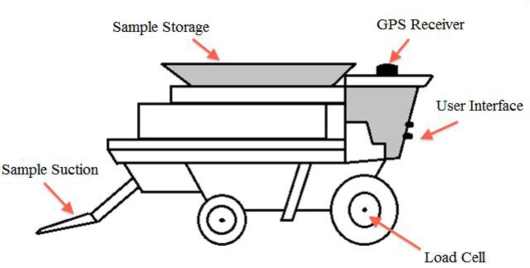California Agricultural Technology Institute
Exploring geo-spatial modeling in almond orchards
Study showing yield correlations to soil type shows how precision agriculture technology could pay off in greater yields, water savings
 As overall crop acreages shrink and drought conditions persist in California, growers
of virtually every type of commodity are searching for more precise ways to enhance
water use efficiency.
As overall crop acreages shrink and drought conditions persist in California, growers
of virtually every type of commodity are searching for more precise ways to enhance
water use efficiency.
A Fresno State agriculture researcher is working to help make it happen for the almond sector. Industrial Technology Professor Balaji Seth recently completed research confirming the viability of geo-spatial yield monitoring to improve efficiency not only in water use but in other management practices as well.
“Although almond production in California is huge, there is little use of yield monitoring technology to capture the fine aspects of variability in field production,” Seth stated. “Spatial variability is common in any field due to several factors, including natural terrain, soil type, and use of agricultural chemicals.”
For example, soil in certain areas of an orchard may have better water- or nutrient-holding capacity. Thus, when a common amount of water or crop nutrients is applied uniformly across an orchard, some sections may not be producing at peak efficiency.
Almond orchard growers have known this for decades and have devised various cultural management practices to overcome spatial variability, Seth noted. However, without proper application of technology and its related science, the fruits of site-specific management may not be realized profitably – precision agriculture technology can help growers automate site-specific decision making.
“Yield monitoring through application of grospatial technology and site-specific crop management is critical for almond growers to maximize profitability,” Seth said. “Almond growers could optimize water and application of inputs based on a soil thematic layer of the field that has a strong correlation to yield.”
The research was conducted on two orchards – a 57-acre plot on Fresno State’s University Agricultural Laboratory, and the 17-acre plot of a cooperating grower in the Fresno area. The work was conducted in three main phases: 1) mapping soil type variations (clay loam, sandy loam, etc.) within each orchard based on soil electrical conductivity (EC); 2) Harvesting and mapping yield; 3) Correlating yield to orchard zones based on soil texture.
To  map soil texture, the research team used a Veris Soil EC Mapper (see diagram at left).
map soil texture, the research team used a Veris Soil EC Mapper (see diagram at left).
For harvest, the team designed and developed a commercially deployable yield monitor with sensing, GPS and GIS technology. The monitoring system (see diagram below left) featured a combination mechanical load cell mounted on the axle of a yield implement, a GPS receiver for geo-referencing each load cell yield data point, a controller, and a user interface with data storage.
GIS software was use to overlay detailed yield data over areas mapped for soil EC, providing data correlating yield to soil EC.
The result was a color overlay map revealing yield variability based on soil texture. The highest yields came from the areas of clay loam, the lowest from the sandy loam areas.
The value of the system is not only in providing a graphic illustration of yield variations based on soil texture, but offering credible information the grower can use in orchard management, Seth said.
 "The information that was obtained from the yield monitoring system established the
yield variability that could be taken advantage of by precision agricultural technology,”
he said. That could include treating certain areas of the orchard with soil amendments,
and/or adjusting irrigation or fertilizer inputs for those same areas.
"The information that was obtained from the yield monitoring system established the
yield variability that could be taken advantage of by precision agricultural technology,”
he said. That could include treating certain areas of the orchard with soil amendments,
and/or adjusting irrigation or fertilizer inputs for those same areas.
In the face of further limited supplies of water and other inputs, yield monitoring may soon become critical for almond growers to maintain a profitable bottom line, Seth said.
“Although adoption of geospatial technology in agriculture has been significant in the country, it has been relatively slow in the Central California region due to the diversity of crops and necessity of multiple mechanized systems in production,” he said. “However, the initial investment in the technology could be retrieved through proper application of technology. It enables growers to optimize inputs as well as protect the quality of the environment.”
Complete details of this work are published in the International Journal of Geomatic and Geosciences, Vol. 1, No. 4, 2011. Technical assistance was provided by graduate student Sunny Sehgal. Research cooperators included Impact Marketing Enterprises & Hydroponic Mastery Inc. of Fresno, California.
For more information contact Seth at balajis@csufresno.edu.